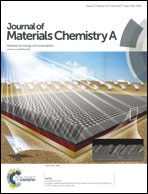Sulfur/carbon nanocomposite-filled polyacrylonitrile nanofibers as a long life and high capacity cathode for lithium–sulfur batteries†
Abstract
Sulfur/carbon (S/C) nanocomposite-filled polyacrylonitrile (PAN) nanofibers (denoted as S/C/PAN) are synthesized as a long life and high capacity cathode material for lithium–sulfur (Li–S) batteries. In the S/C/PAN nanofibers, the sulfurized PAN matrix acts not only as ionic and electronic channels to allow Li+ and electrons to arrive at and react with the S/C nanoparticles, but also as a protective barrier to prevent the S/C nanoparticles from contacting the electrolyte, thus avoiding the discharge intermediates of sulfur to dissolve in and react with the organic carbonate electrolyte. Since the redox reaction of sulfur in the nanofibers occurs mostly at the interior S/C interface through a solid state reaction mechanism, the microstructures and electrochemical interfaces in the nanofiber cathode remain stable during repeated cycles. As a consequence, the S/C/PAN cathode demonstrates a high reversible capacity of 1179 mA h g−1 at a current rate of 200 mA g−1, a high Coulombic efficiency of ∼100% after a few cycles, a good rate capability with 616 mA h g−1 at 4.0 A g−1 and a long cycling stability with 60% capacity retention over 400 cycles, showing great prospect for Li–S battery applications.


 Please wait while we load your content...
Please wait while we load your content...